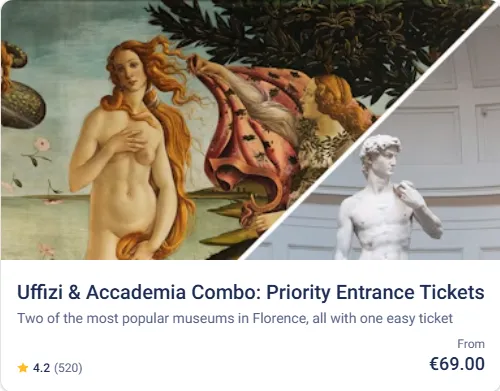Uffizi Gallery Guide
Quick Menu
Uffizi at a Glance
No trip to Italy is complete without a visit to the majestic city of Florence, and no trip to Florence is complete without visiting the iconic Uffizi. With its grand medieval edifices, churches, and museums, visiting this city in Tuscany is on the list of many travelers who have Italy on their bucket list of places to visit around the world. When a trip to this city in the northwestern part of the country is planned, you can be sure that the Uffizi Museum is on top of the list of places to see, guided by the insights of the Uffizi Gallery Guide by Uffizi Now
Story & History
No trip to Italy is complete without a visit to the majestic city of Florence, and no trip to Florence is complete without visiting the iconic Uffizi. With its grand medieval edifices, churches, and museums, visiting this city in Tuscany is on the list of many travelers who have Italy on their bucket list of places to visit around the world. When a trip to this city in the northwestern part of the country is planned, you can be sure that the Uffizi Museum is on top of the list of places to see, guided by the insights of the Uffizi Gallery Guide by Uffizi Now
Construction and Designer
Uffizi was first built in 1560 by Giorgio Vasari , who is considered the father of artistic biographies. Also known as the first art historian, Vasari became famous for his series of artist biographies, Lives of the Most Excellent Painters, Sculptors, and Architects. He is also more than just an art historian, since he was the first person to start building the Uffizi complex for Cosimo I de’ Medici .
The building was constructed over a period of 21 years, with Alfonso Paragi and Bernardo Buontalenti continuing the work that was left behind by Vasari when he died. The Vasari corridor, which is an enclosed passageway that connects the Uffizi with the Palazzo Vecchio and the Palazzo Pitti, is named after its architect. It was asked to be built 5 years after the Uffizi was first commissioned to be constructed, and was finished in a record 5 months.
Early Days
The term “Uffizi” is Italian for offices, and the structure was originally intended to be just that – offices for magistrates of Florence. It was initially used as the legal and administrative offices of the city and as the state archive, or the Archivio di Stato. The building was first named the Magistrature since it was the magistrates’ building.
The structures were never built to house artwork or to become the grand museum that it is today. The transition from offices to museum began innocently enough with the new Grand Duke, Francesco I de’ Medici, son of Cosimo, setting up the top floor of east wing of the building as a private gallery of sorts. He placed the family’s private collection of statues, art objects, and precious artifacts in this part of the structure. The family then set out to increase their collection, slowly using more parts of the building to house these pieces.
The collection of art that was placed in this private gallery grew exponentially, with the members of the family adding more and more to it over the years. The collection spans three centuries of the Medici family, with the last member of the Medici Dynasty, Anna Maria Luisa de’ Medici, signing a document called The Family Pact, to ensure that all of these pieces stayed in Florence. All of the artwork in the Uffizi Museum was bequeathed to Tuscany with the specific and strict edict that none of the collection will ever leave Florence. The gallery was also declared a “public and inalienable public good”, and that it should remain so for locals as well as foreigners who find their way to these hallways and masterpieces.
Present Day
The Uffizi has since become a treasure trove of artwork, mostly from the Renaissance period, but with pieces that date from way back 1st Century A.D. such as Roman sculptures, Hellenistic art, and archeological artifacts from the Etruscan period. The buildings underwent extensive repairs and renovations to help expand the space within to accommodate more artwork that have been in storage. This renovation project, which began in 1989 and has been continuously ongoing, has doubled the space within the museum.
While the Uffizi was being renovated, some of the rooms had to be closed down temporarily for safety purposes. The artwork that were supposed to be in the rooms that were being renovated had to be moved to another part of the building, which prompted new maps of the museum to be made to help tourists find the pieces they wanted to see. Some of the artwork was temporarily unavailable for viewing for some time, like the Botticelli artwork, which were only reopened in October of 2016 after 15 months of being kept closed.
The expansion of the museum increased the number of rooms used to house the artwork to 101, with the renovation using up space from what was previously known as the state archive. The museum’s popularity and the artwork in it draws approximately 2 million visitors every year, with people waiting in line for five hours just to secure a ticket to one of the most popular museums in the world.

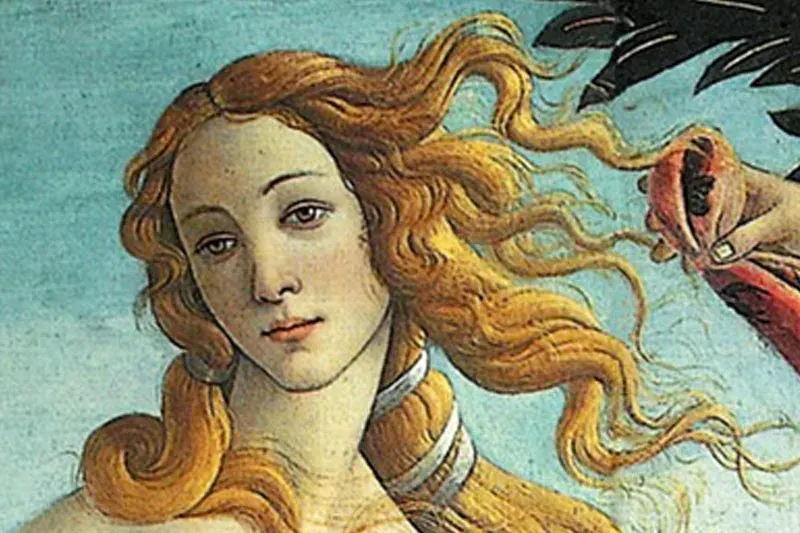
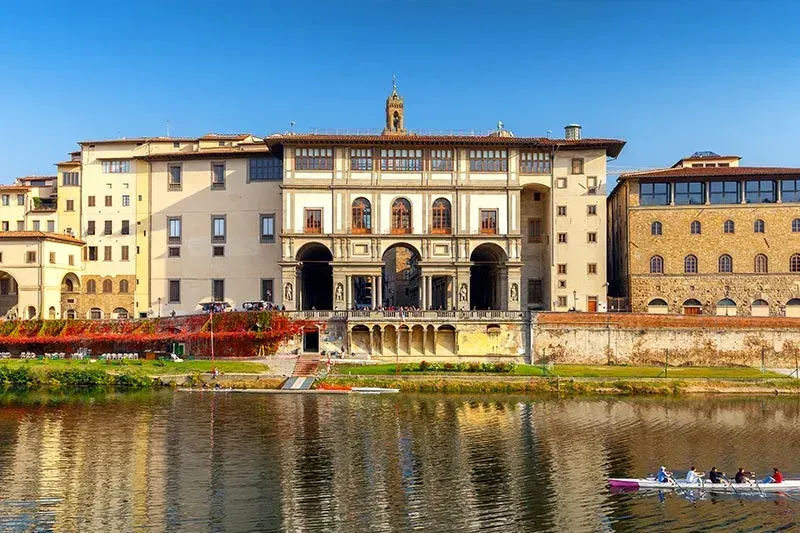
The Building, Floor and Routes
If you want to explore the entire museum without missing a single piece of artwork, you will need to plan your exploration carefully. The building is in a U-shape, with an eastern and a western side, and two floors that house paintings, sculptures, jewelry, and ancient artifacts. The collections are housed in rooms according to the kind of artwork they are.
Some rooms house work by a single artist while others have work from various artists that belong either to a specific period or a particular area of Italy. For instance, work from artists that are from Siena are in a room that is called the Sienese room or Sienese School of Painting. There is also a Florentine room or Florentine School of Painting where work from artists that lived in Florence are displayed.
More popular artists, like Botticelli, Raphael, Michelangelo, and Leonardo, all have their own rooms where their masterpieces can be viewed. There are also rooms that house ancient maps, archeological finds, and sculptures. There are also rooms that are considered artworks by and of themselves, like the Tribune, which is an octagonal room that was commissioned by Francesco I de’ Medici in 1584, and was designed by Bernardo Buontalenti, one of the architects who took over the work of Vasari after he died.
The Tribune, or otherwise called the Tribuna, is a special room inside the museum and is considered a gallery of its own. It was asked to be built by Cosimo’s son to house his collection of coins, jewelry, and his most prized sculptures and paintings in the collection. The room itself is considered a work of art due to the shell encrusted dome ceiling, red velvet walls, and elaborate marble floors. It is said to be the first museum in the building way before the Uffizi itself became the museum.
Interestingly, the Uffizi Gallery has two floors to explore, it is documented as actually three floors, the first floor, second floor, and ground floor. The ground floor is where you enter the building. On the ground floor you will also find the ticket booth, gift shop, bookstore, coat check. At the bookstore you can find great history and art books, souvenirs, and guides to the museum. You can always stop by the museum’s bookstore on your way out after your tour. However, if you want to purchase an audio guide and/or guide book, you should stop by the bookstore before going on your tour. Note: some tours do offer audio and guides depending on which was purchased.
1. All online tickets are to be redeemed at the reservations desk Door 3. Have your email vouchers ready (printed or soft copy). If you did not buy your tickets in advanced you’ll have to wait in the long line at Door 1.
1a. Attention: If you purchased your ticket with audio guide from Uffizi Now, go directly to the location specified on the voucher.
2. Next step is go to Door 2 on the ground floor, here you will enter and go through security and coat check (if needed). Then you will proceed right to the second floor, and pass the “Lorraine Atrium” and go to the “Eastern Corridor” to start your Uffizi tour.
3. After you have seen the exhibits on the second floor you will go down to the first floor to continue your tour.
4. After you’ve seen the first floor you will proceed back down to the ground floor to exit.
Second Floor
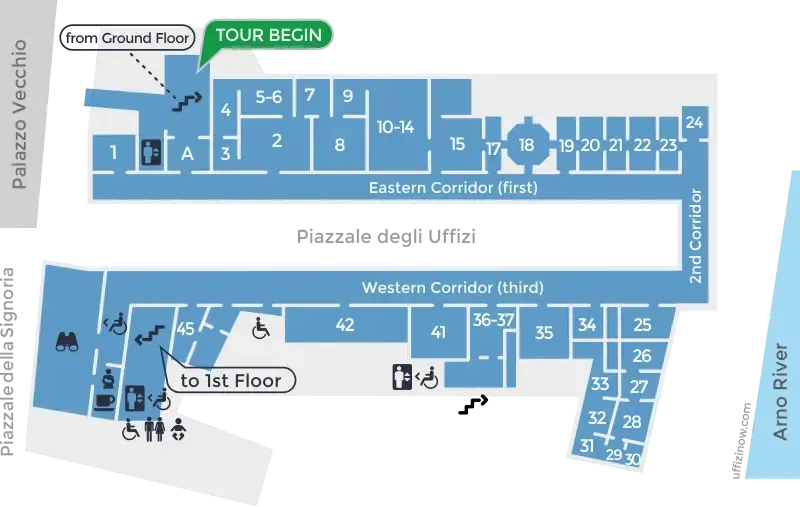
First Floor
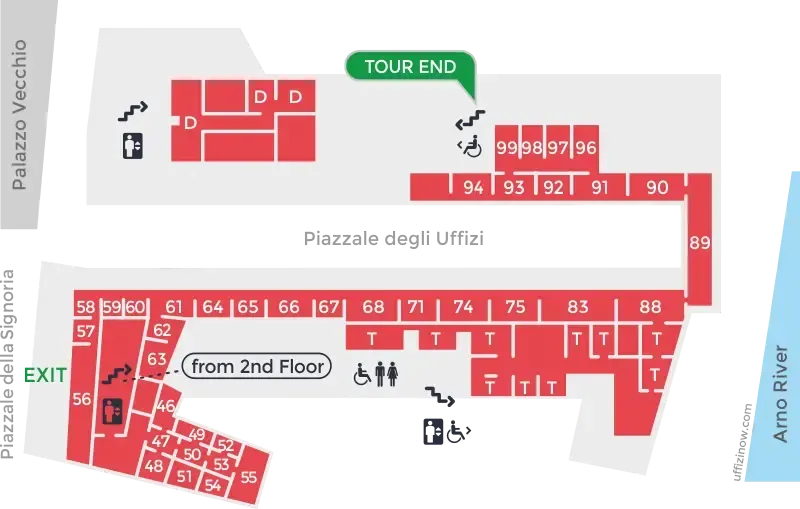
Also See
➡️Collections & Artwork List and Map
➡️Download Uffizi Guide Map
Reservations & tickets pick-up
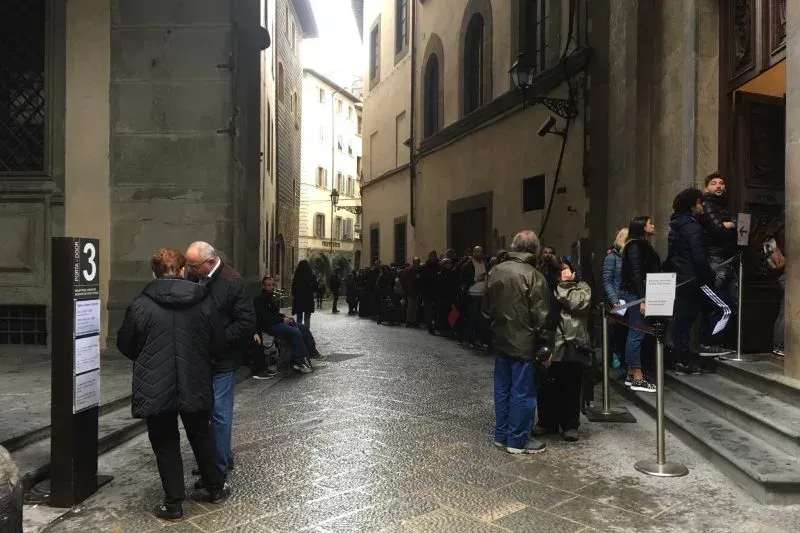
Lorraine Atrium – ticket check
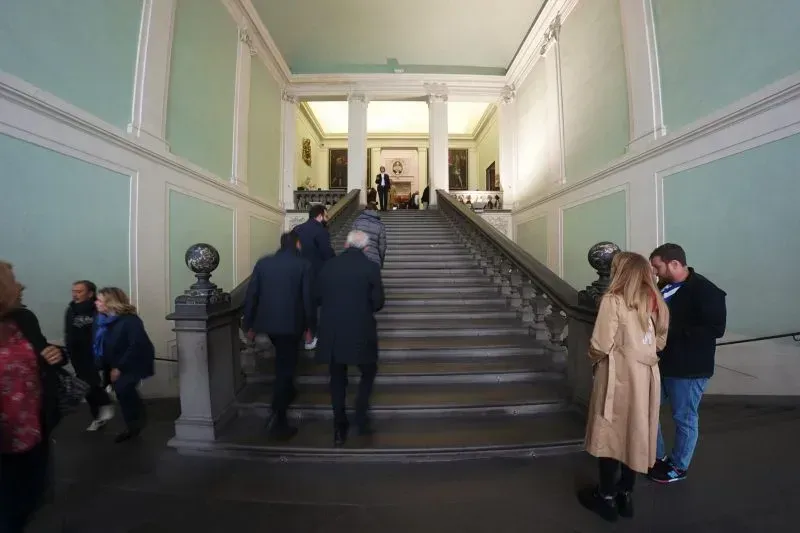
Eastern Corridor – tour begin
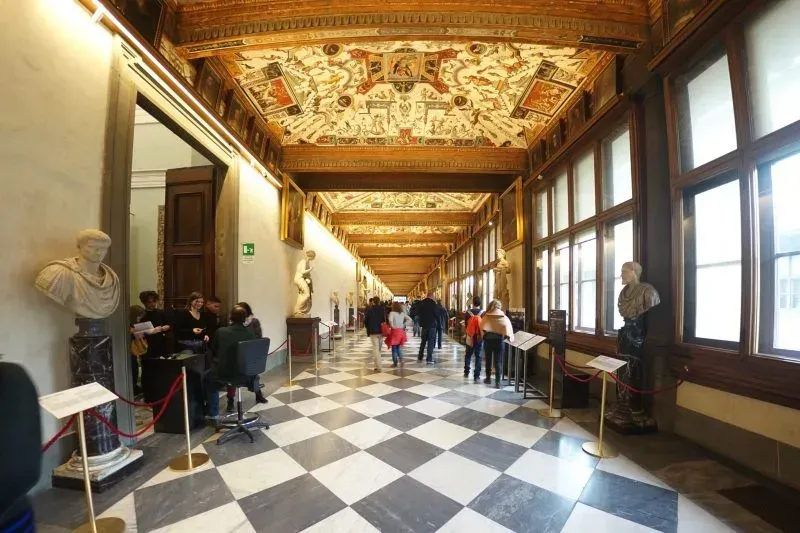
Second Floor
The second floor of the Uffizi is where you will start your tour of the museum, if you were on a guided tour. If you are going around the building on your own, it is also advisable that you start your explorations here since this is where you will find the more important pieces of the museum being displayed. It is also where most, if not all, audio guides start their definitions and explanations regarding the pieces found in the museum.
The second floor of the museum has 45 rooms, all of which are connected by three corridors, the east corridor, west corridor, and the second corridor at the end. There are 24 rooms on the eastern side of the building, with the Tribune being one of them, and 21 rooms on the western side, with the Michelangelo, Rubens, and Rembrandt rooms found on this side of the 2nd floor.
Eastern Corridor
You start your tour of the museum here, and you begin with a visit to the Archeological room, which is in the northeastern part of this floor. The collection that you will find in this room is made mostly of marble and most of these come from Rome. As you work your way towards the other end of the eastern hallway, you will come across rooms that carry early renaissance pieces, artwork from the gothic era, and 14th century Sienese as well as Florentine artwork.
On this side of the museum and on this floor, you will find rooms with work by Filippo Lippi and his son Filippino, as well as paintings by Antonio del Pollaiuolo like Hercules and the Hydra and Hercules and Anteus. This is also where you will find the very popular works of Sandro Botticelli on display.
In one of the larger rooms along the eastern corridor, you will find 15 notable pieces by Botticelli, with the more popular La Primavera (The Spring) and the Birth of Venus commanding the most visitors. Beside the Botticelli room is the one that is occupied by work of another master, Leonardo Da Vinci. Here you will find the painting The Adoration of the Magi, and The Baptism of Christ, which is one of his earlier works and which was painted mostly by his master Verrocchio.
On this same side of this floor are the Maps Room, the Mathematics Room, and rooms that carry works by Venetian, Sienese, and Lombard painters of the 15th century. Right in the middle of this great corridor is the Tribune, which is considered a gallery all its own and a masterpiece in architecture.
At the very end of the hallway is the Cabinet of Miniatures, which is an oval room that carries miniatures from different periods and schools. These are mostly the collection of the Medici family and features mostly figures and portraits.
Western Corridor
The western corridor of the 2nd floor of the Uffizi is where you will find another treasure trove of artwork and priceless pieces that date back to the 15th century. This is also where you will find the works of Michelangelo, Rubens, Rembrandt, and Raffaello. Some of the rooms on this side of the building may be closed on your visit due to ongoing renovations and repairs, so you might want to check with the Uffizi staff before you schedule your tour so you know which rooms are not available to you.
Aside from the work of the masters, you will also find collections from northern European painters and Venetian artists in this part of the building. There is a room here that carries ancient inscriptions and another that has Greek portraits. Still on this side of the upper floor of the Uffizi are the Room of the Hermaphrodite, Sala della Niobe, some classical art and the San Marco Sculpture collection.
You will also find some of the works of Caravaggio in this part of the museum, along with paintings of the 18th century, the Parmigianino collection, and the works of Andrea del Sarto. Here you will also find the Sala delle Veronese, the room where paintings from Florentine painters are on display, and the Cinquecento Corridor. This side of the building also houses some of the works of Bassano and Tintoretto.
The First Floor
While most of the notable artwork in the Uffizi can be found on the second floor of the structure, the first floor has quite a collection that you should not miss. This is where you will find Hellenistic marble sculptures, work by Vasari, and pieces by foreign artists from the 16th to the 18th century. This is where you will also find modern-style artwork and work by lesser known Italian artists.
There are approximately 56 rooms on the first floor of the museum, and some of these are designated the Red Rooms, while others are called the Blue Rooms. There are also the Modern Manner rooms and the Caravaggesque Rooms. Some of these rooms are being used to temporarily house some of the exhibits while the second floor is undergoing renovations.
The Blue Rooms, which are located on the northwestern area of the Uffizi, house the artwork of foreign artists. These include works from Spanish and Dutch painters, French painters, and Flemish painters. These are works that range from the 16th century to the 18th century.
The Red Rooms , which are found on the western side of the building, is where you will find works by Pontormo, Vasari and Allori, Parmigianino, Correggio, and 16th century work of painters of the Lombard school. Also to be found in this part of the museum is the Hellenistic sculptures in marble, work by Florentine painters of the 16th century, Bronzino and the Medici, Rosso Fiorentino, and Andrea del Sarto.
To the east of this floor are the collections of Caravaggio, Bartolomeo Manfredi, Gherardo delle Noti, and other Caravaggesque painters. Caravaggesque painters are artists from all over Italy that emulate the work of Michelangelo Merisi da Caravaggio, which is a style that depicts realistic human figures in contrasting light and dark situations. Artists that follow this style of painting include Francesco Rustici of Siena, Spadarino of Rome, and Giovan Battistello Caracciolo of Naples.
Also on this floor, in the Yellow Rooms, are paintings by Sienese and Florentine painters of the 17th century , which can be found on the northeastern side of the building. Other rooms you should not miss exploring on the first floor are the ones that house works by Titian, Raffaello, Sebastiano del Piombo, and the works of 16th century painters from Lombardy. All of these can be found on the first floor of the Uffizi, and can be easily located with the help of a map with numbers on them.
The Corridor and the Vestibules
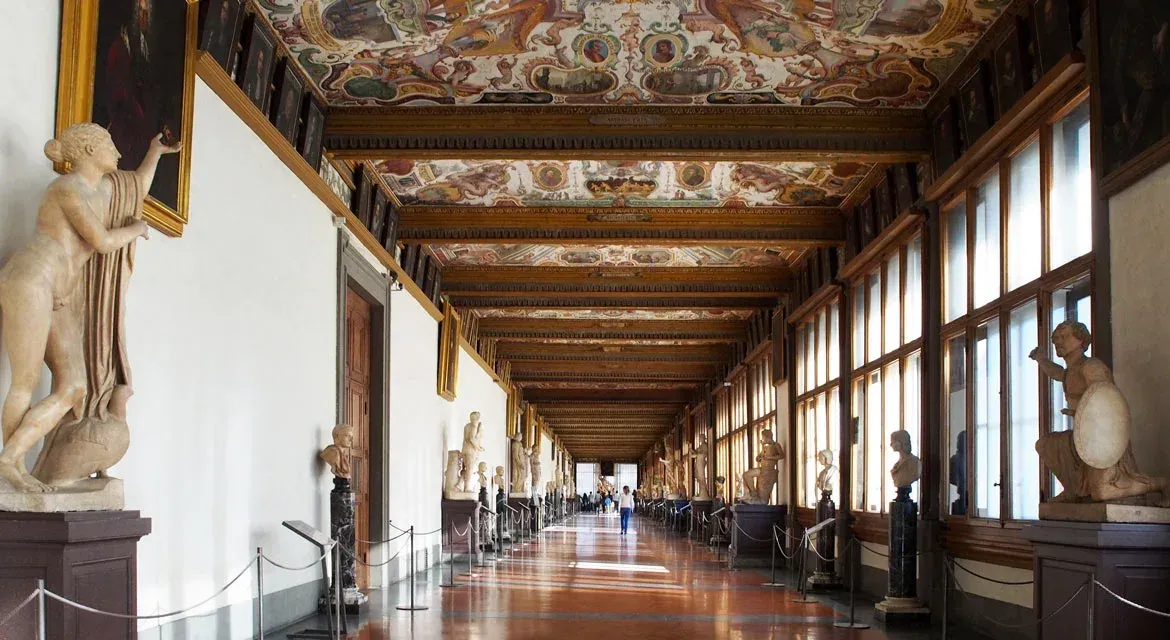
Photo by Petar Milošević
The corridors of the Uffizi are not just hallways that you walk through to get to the rooms that you want to see. These are works of art on their own and are worthy of your time and attention when you visit the museum. You start with the Eastern Corridor (first corridor), then head on down to the connecting short corridor, which is the second corridor, which then connects you to the Western Corridor (third corridor).
The First Corridor, also known as the East Corridor, has a ceiling painted with frescoes that are the work of Alessandro Allori and his team of equally talented artists. Also along this corridor are Greek statues that are part of the Medici collection, together with Roman statues from ancient times. Also along this hallway are small portraits of famous men, called the Giovo series, and the larger Aulica series, which are bigger portraits of the Medici family.
The Second Corridor, which is the connecting hallway between the east and west corridors, is located at the very end of this U-shaped building. Just like the First Corridor, this part of the building also has frescoes on the roof painted between 1696 and 1699, this time however the frescoes were painted by Giuseppe Tonelli and Giuseppe Nasini. Also called the Short Corridor, this hallway has Greek and Roman statues lining both sides. Instead of paintings, this hallway offers you views of the world outside, with the Vasari Corridor, Ponte Vecchio, and Piazza della Signora included in the sights you can enjoy from here.
The Third Corridor, or the West Corridor, is just like the first two corridors in this building, which are painted with impressive frescoes on the ceiling. The images here were created by Cosimo Ulivelli, Angelo Gori, and Giacomo Chiavistelli in the years between 1658 and 1679. These original works however were damaged in a fire in 1762, prompting the repainting of the frescoes by artists Giuseppe Terreni, Giuliano Traballesi, and Giuseppe del Moro. Much like the other two hallways, you will find Greek and Roman statues lining the sides of this corridor. At the very end, you will find the Laocoon Group marble sculpture by Baccio Bandinelli, which also goes by the name Laocoon and His Sons, which is a copy of a sculpture located in the Felice de Fredis vineyard.
Aside from the corridors, you also need to pay careful attention to the vestibules that lead to and from these corridors. The entry vestibule, which is connected to the Eastern Corridor, it filled with artwork that will also capture your attention. Here you will find sculptures and busts, some of which depict the members of the Medici family. Also in the entrance vestibule are altars, status, and sarcophagi that are sure to hold you in awe.
On the other end of the U-shaped building, near the room that carries the Michelangelo and Florentines collection, is the exit vestibule. This too has a collection of paintings and sculptures that you should take time to enjoy. Here you will find a collection of Roman altars and epigraphs, which were donated to the museum by Prof. Detlef Heikamp.
The Tribune
One of the noteworthy rooms located on the second floor of this epicurean structure is the Tribuna, which is an octagonal room that was built in 1584 upon the request of Francesco I. This room was built to hold the paintings and artwork that Francesco I found to be of most value to him, and here he displayed paintings, sculpture, and even jewelry that he considered to be his biggest joys. This room has been said to be a museum on its own and was the first museum of its kind in the area before the entire Uffizi itself was declared a gallery.
The Tribune is also considered an art piece itself, with its domed ceiling encrusted with precious shells, its red velvet walls, and its ornate marble floor. Aside from the paintings and sculptures you find in this unique room, you will also find the room itself breathtaking and worthy of being called art. Designed by Bernardo Buontalenti, this room is also the subject of a painting by Johan Joseph Zoffany, which is entitled the Tribuna of the Uffizi, which is part of the Royal Collection of the United Kingdom.
Other Places of Interest in the Museum
While enjoying the works of art in the museum is the main reason why you came to the Uffizi in the first place, taking in such majestic pieces for hours on end can become an overwhelming and mind-numbing experience. This is why it is imperative that you break your tour with visits to some of the other parts of the museum that can allow you a breather or two from all that majesty. Some of the other places you can visit and explore here include Lorraine Atrium, the Vasari Corridor, and the Terrace that looks over the Loggia dei Lanzi.
Lorraine Atrium
This is actually called the Entrance Vestibule by many and is located at the top of the grand staircase. This is where you will find portraits and busts of members of the Lorraine and Medici family. If you were to take a guided tour of the museum, your tour guide will explain to you the importance of the many people in this atrium and what contributions they made to the history of Florence.
Vasari Corridor

While not necessarily considered a part of the gallery itself, the Vasari Corridor is still part of the entire structure and is one of the sights that you should not fail to check out when you get to the Uffizi. This corridor, which is named after the person who designed it, is about a kilometer long and connects the gallery with the Pitti Palace. This elevated and enclosed passageway is now a gallery in its own right, and can be accessed via the first floor of the Uffizi museum.
In this hallway, you will find paintings from the 16th and 17the century, with a collection of self-portraits by various artists like Chagall and del Sarto gracing these walls. One thing you will notice when you walk down this quiet corridor is the area where damaged paintings are hung. These were damaged in a terrorist attack in 1993 and were pieced together and hung back in their original places as a reminder of such a senseless act.
A visit to the Uffizi without passing through the Vasari Corridor is something you don’t want to do. Aside from the artwork, you will also enjoy the views from the corridor and the feeling of being apart from the rest of the world. Walking above the crowds on the streets below and seeing the Arno river from this vantage point gives you a surreal yet exhilarating experience that only this corridor can give.
The Uffizi Terrace
At the end of the building’s second floor, you will find the cafeteria and café over the Loggia dei Lanzi that gives you a majestic view of the surrounding city of Florence and the Palazzo Vecchio. This café and cafeteria is where you can take a breather from your art exploration and where you can grab a bite to eat or a drink. Even when you are not hungry or thirsty, a short stop here will help invigorate you since it gives you a chance to go outdoors and to view the city from a high vantage point.
How to Tackle the Many Rooms of the Uffizi
When you explore any museum or building, it is logical for you to start on the first floor and to work your way up. With the Uffizi, however, you explore the museum from top to bottom. In short, you first head to the top floor, and check out the collections there before you proceed to the first floor rooms and the artwork found there.
The reason why you should climb the grand staircase to the second floor first before exploring the rest of the museum is because this is where the major works of art are found. The second floor is where the crème de la crème of Renaissance art can be found, and these are artworks that date from the 13th century to the 18th century. When you visit the museum, make sure you have more than enough time for all the floors so that you don’t miss out on any of the fabulous pieces found here.
If you are going to the museum without a guide and are planning on buying your tickets onsite, be there extra early so you don’t have to stand too long in line for your tickets. Ticket booths and the museum itself open at 8:15 in the morning. The museum closes at 6:50 PM but announcements of the building closing starts at 6:35 PM. The ticket booth stays open only until 6:05 PM, and you can purchase tickets at this hour here for the next day.
The best thing to do for first time visitors to the museum is to book an early tour so you have enough time after the guided tour of the museum to check out the rooms more carefully and at your leisure. Visitors to this majestic structure however find that a single trip to the Uffizi is never enough, and a second or even third tour of this historic building with its priceless art pieces is often necessary. Before you go, you should familiarize yourself with the layout of the museum’s 3 floors so you know which rooms carry the more popular pieces.
Knowing how to navigate the Uffizi will also prevent you from wasting precious time finding your way around since you will know exactly where specific pieces can be found. Give yourself enough time to enjoy the other parts of the museum, such as the Vasari Corridor and the coffee shop on the terrace, which gives you a great view of the Palazzo Vecchio and the city beyond it.
Collections and Artwork You Should Not Miss
While it is understood that a single visit to this majestic museum is not enough to take in all the magnificence that is found within, there are some pieces that you should not neglect to see on your first trip here. These notable pieces are some of the most talked-about and most revered in the world, which should make you put them on the top of your list.
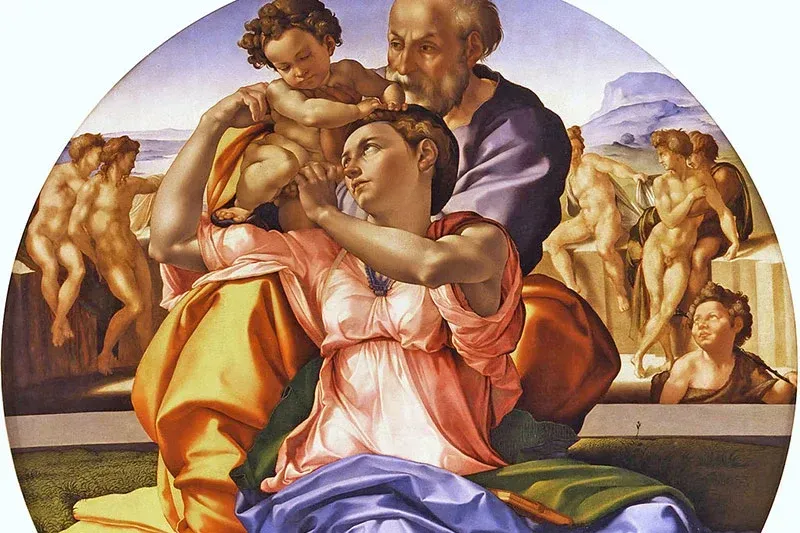
Doni Tondo by Michelangelo
This is actually the only painting by this master in all of Florence, and is considered one of his masterpieces as well as of Italian art of its era. Tondo is a type of circular artwork or painting, and was very popular in the 15th century. This round art piece features the Holy Family and is a painting that was commissioned by banker Agnolo Doni. This painting was made during the same time the famous David was sculpted.
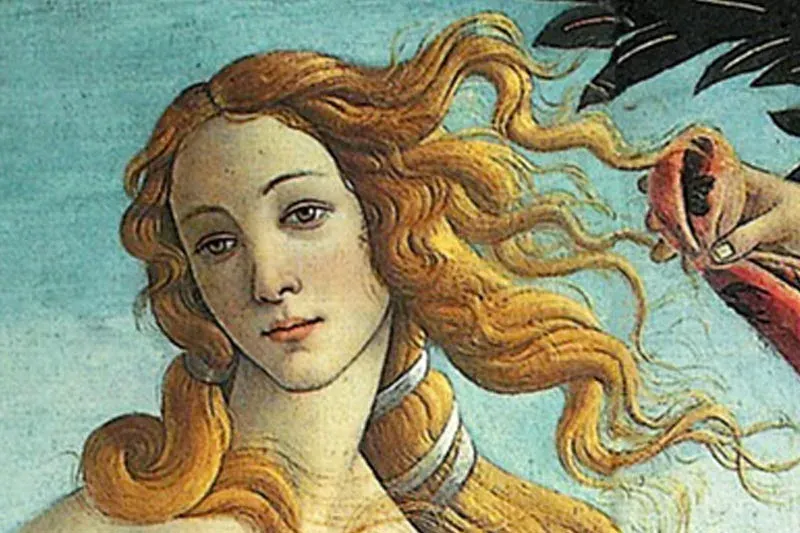
The Birth of Venus by Botticelli
Probably the most popular painting in the entire gallery, this piece by Sandro Botticelli was painted in the early 1480s. It depicts the goddess Venus on a shell, naked and trying to cover her body. To the left of her are nymphs blowing flowers and wind at her, while to the right is her handmaid Ora, waiting to clothe her with a colorful cloak.
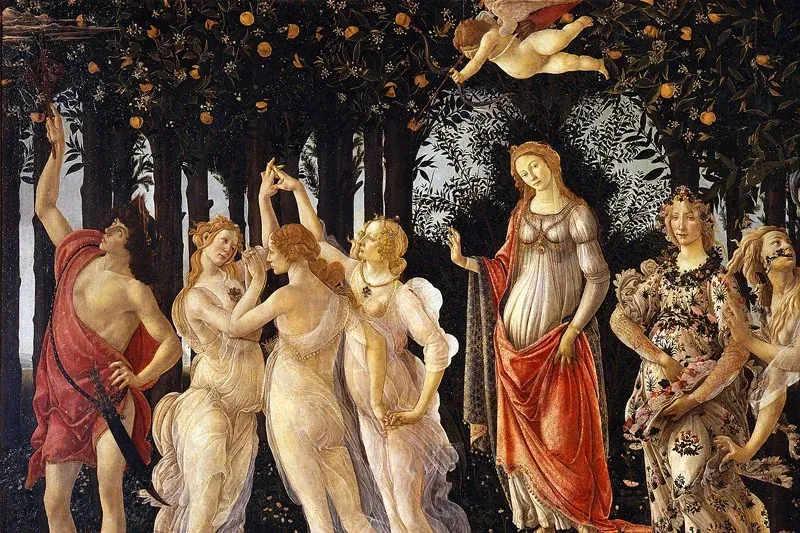
La Primavera (Allegory of Spring) by Botticelli
Another one of the more popular pieces by Botticelli, this painting, which is found in the same hall as the Birth of Venus, was painted sometime between 1477 and 1482. The meaning of the painting has been the source of debate over the years, with numerous theories revolving around the significance of the figures surrounding Venus in the middle. The painting features 9 figures, with Venus in the middle, Zephyrus to the far right with Flora and Spring, and Mercury to the far left. The three Graces to the left of Venus are dancing while a cherub flies above the goddess.
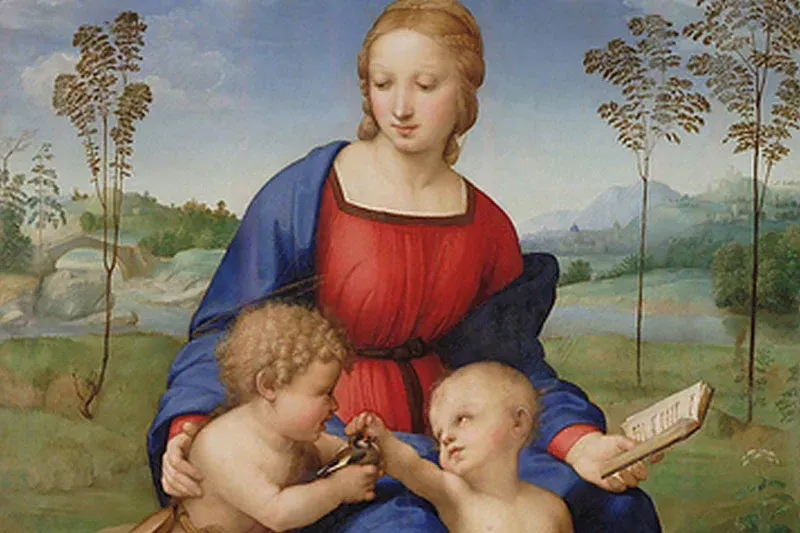
Madonna of the Goldfinch by Raphael
This recently restored painting by Raphael shows the influence of his master, Perugino, with the pyramid composition and soft light effects that the piece has. Also called the Madonna del Cardellino, this painting, which was made in 1506, is a true representation of Raphael’s unique style, which depicts characters with very sweet faces, has bright colors, realistic-looking backgrounds, and a sense of closeness between the subjects of the image. The artwork was damaged by a building collapse, and has been the focus of restoration over the years.
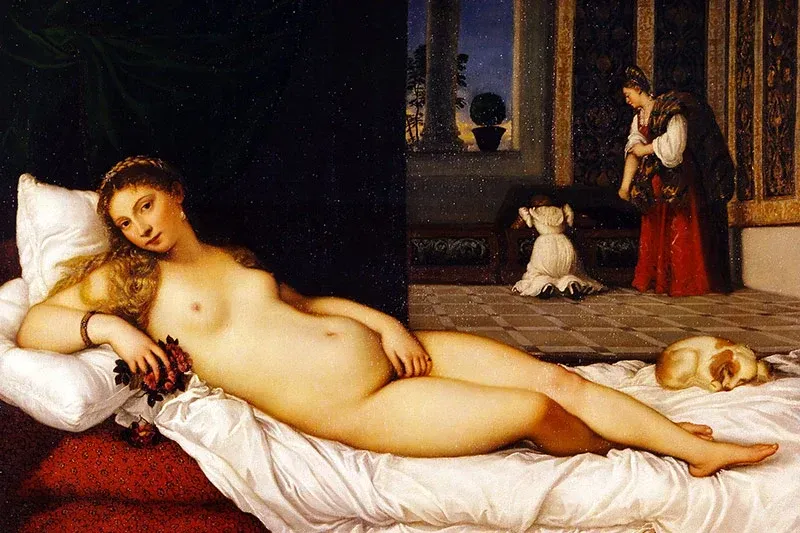
Venus of Urbino by Titian
Another representation of Venus, this time by the artist Titian, this painting was commissioned by the Duke of Urbino and was meant as a gift for his wife. It is said to be a reminder to the young wife of what marriage is supposed to be, with images of the goddess symbolizing the eroticism of a wife’s role in marriage. Other images in the painting represent motherhood (maid with young girl in the background) and the dog at her feet as a symbol of loyalty and fidelity.
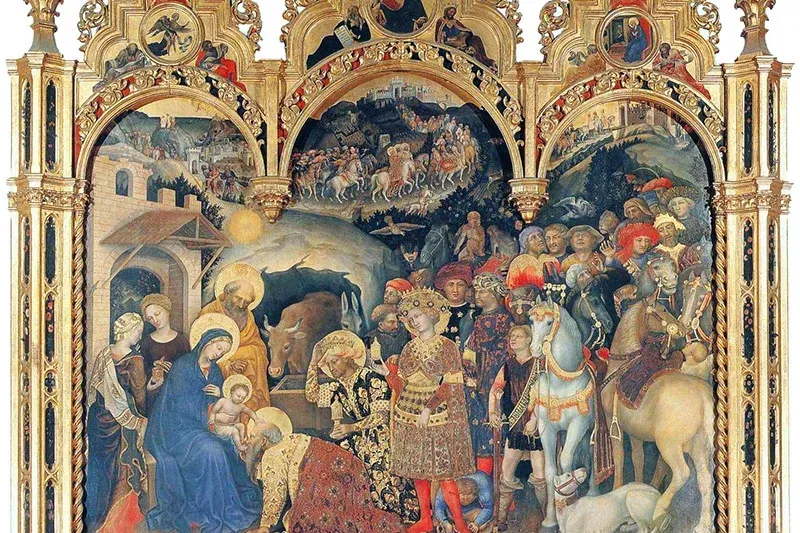
Adoration of the Magi by Gentile da Fabriano
Also known by the name Pala Strozzi, this painting which was made in 1423 is the work of Gentile da Fabriano. It is an example of international gothic style of painting and comes with a fairy tale atmosphere, elegant look, and sophisticated figures. This was commissioned by Palla Strozzi, a wealthy banker, for his family’s chapel. This masterpiece can be found in rooms 5 and 6 on the Eastern Corridor.
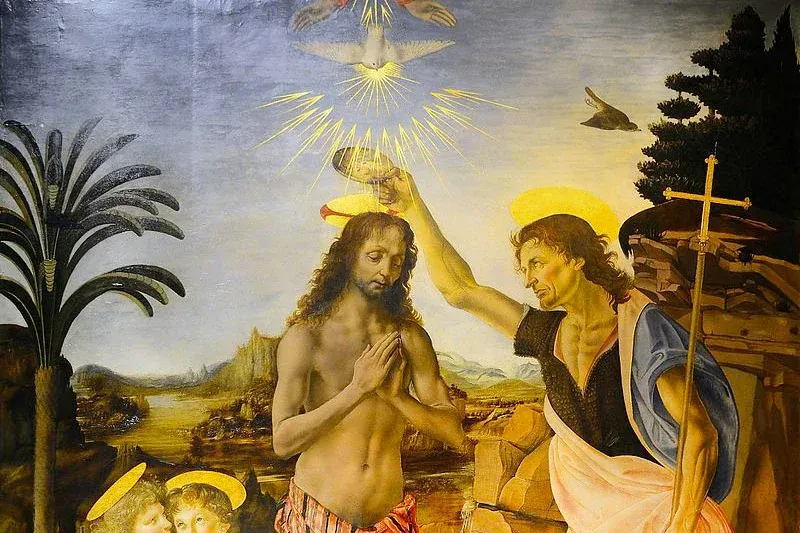
The Baptism of Christ by Leonardo da Vinci
While this painting was actually made mostly by Da Vinci’s master, Andrea del Verrocchio, it is still considered one of this master’s best works. His only contribution to this painting is the angel with its back to the viewer. This part of the painting is noticeably softer than the rest of the painting, with their stiffer looks.

The Annunciation by Leonardo da Vinci
Completed in 1472, this piece was made also by Da Vinci and Verrocchio. It features the Virgin Mary to the right and an angel to the left. The image of the Virgin Mary was made by Verrocchio while the angel was made by Da Vinci. While Verrocchio used lead based paints, Leonardo did not, which is why when the painting is x-rayed, the angel is invisible while the Virgin Mary’s image is not. Da Vinci was only twenty years old when he did this piece of art.
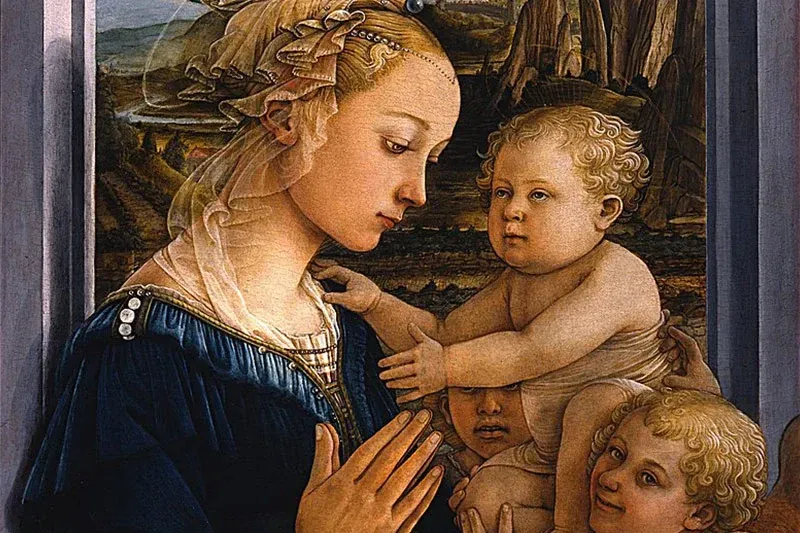
Madonna with Child and Two Angels by Filippo Lippi
Painted in 1465, this depiction of Mother Mary with Jesus is one of the most popular paintings of the Renaissance. It has been said that the Virgin Mary in this painting bears a strong resemblance to Filippo’s wife, Lucrezia Buti. It has also been said that this painting and Filippo’s style had a strong influence on Botticelli’s work, with Lippi being a student of this master and a close friend of Filippino, which is Filippo’s son.
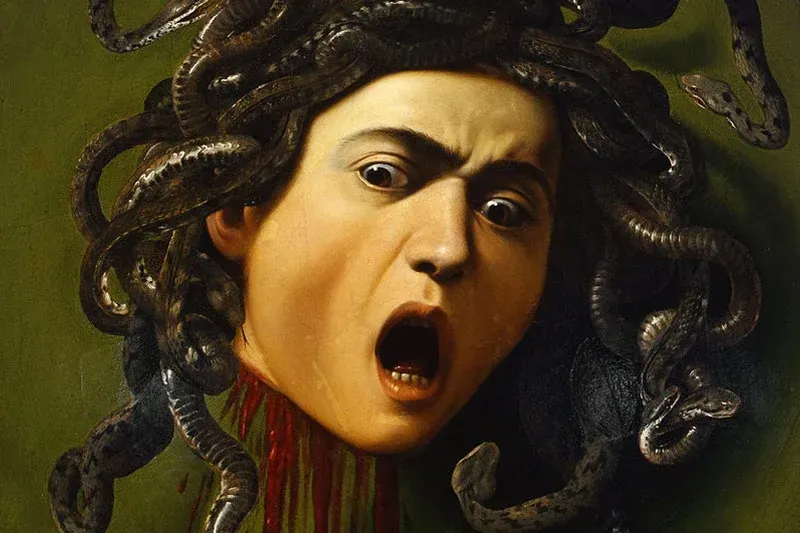
Shield with the Head of Medusa by Caravaggio
Located near the door of the room dedicated to this artist, this intimidating and somewhat scary image of the Medusa on this shield is one of the more popular pieces by this artist in the museum. This is found alongside other pieces that the artist is known for, such as The Sacrifice of Isaac and Bacchus.
Apart from these individual pieces, there are also a few halls or rooms that you should not miss on your first visit to the Uffizi. These include the rooms that contain archeological artifacts (Hall 1), Lippi’s paintings (Hall 8), the Botticelli collection (Halls 10 to 14), and the room that contains the work of Rubens (Hall 41) and Rembrandt (Hall 44). Of course, the entire museum should be explored and all artwork enjoyed when you visit, but these are some of the works and rooms that you should not fail to give your attention to. See also Collections & Artwork List and Map.
Uffizi Collections
In this gallery, you will find not only paintings and sculptures, but also notable architectural styles, prints, drawings, and old books that are considered priceless.
Paintings – There are hundreds of paintings for you to view in this museum, some from the masters of Renaissance art and some by their followers and students. There are also paintings by foreign artists, local painters, and artists from all over Italy as well as all over Europe. There are collections from specific art disciplines, like the Sienese School and Florentine School, and collections from specific centuries. There are halls that are filled with portraits, landscapes, and paintings that emulate the styles of the masters.
Architecture – Also worth noting are the architectural designs of some of the great architects of bygone eras, such as Vasari, Buontalenti, and Parigi. Explore the many parts of this U-shaped building and the surrounding structures, such as the Vasari Corridor and the Pitti Palace, to truly appreciate the majesty of these buildings. Inside, some of the more notable areas of the building include the entry vestibule, the grand staircase, the Tribuna, and the elaborate corridors.
Sculpture – Another kind of art medium that you will find in abundance in this museum are sculptures. These can be found in just about every part of the building, from the vestibules to the hallways to the halls. Most of the sculptures you will find here are Roman in origin however there are some Greek sculptures here too. You will also find a number of more modern pieces in the museum, but majority are ancient and date back to the 1500s and 1600s. Some of the sculptures are full figures while others are busts of famous individuals from history.
Prints and Drawings – The Department of Prints and Drawings are found on the first floor of the gallery, and the number of prints and drawings you will find here is roughly 177,000 pieces. Most of the works you will find in this massive collection include Tuscan art, Renaissance sketches, and portraits as well as drawings made by some of the masters. You will find drawings by Raffaello, Parmigianino, Rembrandt, Sarto, and many more in this huge collection.
Books and Archives – If you are into history and old books, then visiting the Library in this museum is a must for you. it has preserved manuscripts, artistic historical publications, first edition books, and periodicals that date back to as early as the 16th century. This collection has about 78,600 pieces in it, with some housed in the Historical Archives and Research Department and others housed in the Uffizi Library (formerly known as the Magliabechiana Library).
Services
When you visit the Uffizi, you will find that not only will you be able to view the numerous art pieces within but you can also enjoy doing so with the many conveniences and services that the museum has to offer. Here are the services you can expect to find when you visit the gallery:
Audio Guide
This can be purchased at the entrance to the gallery, at the bookstores on the ground floor. These come in many different languages and these include Italian, English, French, German, Spanish and Japanese. Each audio guide costs around € 6,00 for solo and € 10,00 for a pair. However, you are much better off buying your Uffizi Tickets & Audio Guide in advanced to save yourself a lot of hassle.
Click Here To Purchase You Uffizi Tickets & Audio Guide
Café and Restaurant
Located on the second floor on the terrace, this café is where you can enjoy a cup of good coffee and some food while taking in the view around you. You can grab a quick bite to eat here if you find yourself hungry during your tour of the museum or you can have a drink here as you relax after a long day of exploration.
Cloakroom
This is located near the entrance of the building and is available for visitors who have large bags and other items that are not allowed into the museum. If you are bringing with you your own drinks, umbrellas, and backpacks, these must be deposited here before you can be allowed to enter. Don’t worry, deposit of items is free of charge.
Post Office
If you are thinking of sending postcards of the museum to family and friends back home, the Uffizi conveniently has a post office that can help facilitate these. Purchase a souvenir or two at the bookshop and send this immediately to your loved ones right on the spot. There is also a currency exchange here, if you forgot to change your money to local currency for your purchases.
Book Shop
You can choose to purchase guidebooks to the museum when you enter or before you leave since there are three book shops here – two at the entrance and one at the exit. If you want to buy specialized art books, you can only get these at the bookshop at the entrance. Souvenirs and gifts can also be found in these bookshops. Make sure to make your purchases before you exit the building since these are only found inside the gallery and cannot be accessed from the outside without usable museum tickets.
Disabled Persons
Accessibility is not a problem in this ancient building since it has been fitted with elevators at both the entrance and exit. Ramps are also available at the entrance of the museum, although some assistance may be needed to get up these. The elevators are for the use of staff, people with mobility impairments and disabilities, and the elderly. If wheelchairs used by disabled individuals are too large for the elevators, a smaller wheelchair that can fit can be requested from the staff. Restrooms that come with disabled access are found on the Western Corridor and can also be accessed with the help of museum staff.
Those with visual impairments can also enjoy the museum with the help of the Uffizi by Touch Tour. These focus on the artwork that can be appreciated through the sense of touch, such as the sculptures and busts.
The café and the terrace can also be accessed by individuals with disabilities with the help of museum staff since a stair lift is needed to get here.
Timetable
The Uffizi is open from Tuesdays to Sundays, and is closed on Mondays, Christmas Day, New Year’s Day, and May 1st.
Operating hours are at 8:15 AM to 6:50 PM.
Ticket booths open at 8:15 AM and close at 6:05 PM.
Announcements for the closing of the museum are made at 6:35 PM to ensure that everyone has enough time to purchase souvenirs at the bookshops before these close, and to head to the exit at a comfortable pace.
It is estimated that a tour of the museum can take at least 4 hours, but spending an entire day here is sometimes recommended, if you are planning on maximizing your visit to the Uffizi.
How To Get To The Uffizi Gallery
The Uffizi is located between the Arno River and the Palazzo Vecchio. It is also right next to the Piazza della Signoria. To get to the gallery, you can take a cab from your hotel or you can take the shuttle bus to the station near the museum, which is the Santa Maria Novella Station. This train station is where you can also park your car, if you are heading to museum using a rental car. From the station, the museum is just a short walk away to the southeast.
To get to the Uffizi, you will pass by the Basilica of Santa Maria Novella, the Cattedrale di Santa Maria del Fiore, and the Strozzi Palace. If you already have your tickets, head towards the left wing of the building. If you still have to purchase your tickets, you need to head to the right side to get to the ticket office.
The address of the Uffizi Gallery is:
Galleria degli Uffizi
Piazzale degli Uffizi, 6
50122 Florence, Italy
Phone: +39 055 238 8651
Accommodations Near the Uffizi
If you don’t want to waste any time in getting to and going around the museum, it might be a good idea for you to choose accommodations that are near the Uffizi. Aside from being near the museum, it also allows you the convenience of being near the other tourist attractions and sights that can be found around this iconic gallery.
There are hotels, rental homes, rental apartments, and B&Bs located within a few kilometers to a few hundred meters of this area which you can choose from.
Museum Tickets
When you visit the Uffizi, you will find that there are three (3) kinds of tickets available – Full, Reduced, and Free.
Full Tickets are the most common and is what most people are required to purchase for a visit to the Uffizi. These are for all EU citizens above the age of 25 and tourists from other parts of the world that are over the age of 18.
Reduced Tickets are for citizens of EU that are under the age of 25 and above 18 years of age. You will need to present proof of your age upon purchase of such tickets. These tickets can also be purchased by EU teachers from public educational institutions, as long as proof of their position as such is presented upon purchase of the ticket.
Free tickets are for children under the age of 18 (proof of age will be required upon entry), EU citizens with disabilities and one member of their family accompanying them, members of the International Council of Museums (ICOM), and journalists who can provide an ID showing their status as such.
For schools that plan an excursion to the museum, requests for such a tour will have to be sent to [email protected] ahead of time to ensure that tours can be properly scheduled and facilitated.
Experiences at the Uffizi Gallery
As if touring the famous gallery and viewing the masterpieces in it isn’t enough, there are a number of tours that can give you wonderful experiences that will make your trip even more memorable. Apart from enjoying the fabulous artwork in the museum, these special events and experiences will give you something extra to remember and enjoy.
Early Entrance with Breakfast Tour – If you want to start your tour of the museum early and have breakfast while enjoying the view of the city, you can do so with an early entrance tour that comes with breakfast at the terrace café and restaurant. This “skip-the-line” tour is booked online and is one that takes three hours with a guide and only a few other individuals, which makes it more intimate and memorable.
This tour of the museum starts at 8 AM, giving you early access to the gallery’s masterpieces while others are waiting in line for their tickets, plus a sumptuous Italian breakfast on the terrace over the Loggia dei Lanzi. After breakfast, you will also be given the chance to explore the museum on your own.
Uffizi Small Group Night Tour – If an early start is not your thing, and you are more of a night person, then you might want to do the night tour of the Uffizi with a few other night owls. This tour takes you around the museum at night with a small group of like-minded individuals, and starts at 6:30 PM, just a few minutes after tickets booths close and the museum is about to close for the night. This tour will give you the chance to enjoy the artwork within without the huge throngs of people that are usually at the museum during the day.
Uffizi Sunset Tour with Aperitif or Dinner – This is a shorter tour that takes you around the museum at 6:30 PM, and lasts about an hour and a half. This tour happens only on Tuesdays, so you might want to check your vacation schedule to ensure that you can accommodate such an experience. Your guide will take you to the most famous artwork of the museum and will conclude with either an aperitif or dinner, depending on which option you choose.
Wine Tasting and Exclusive Dinner at Uffizi – This particular tour is considered a VIP one since it allows only up to eight (8) people to join in at a time. You can also book this tour with only two (2) people experiencing it, making it a romantic and unique date. You can try to experience this private tour and dinner with wine tasting any day of the year, except on Mondays, when the museum is closed, and on Tuesdays. This tour starts at 7:00 PM when the regular museum visitors have left and ends an hour before midnight. It ends with a four-course dinner and wine-tasting with an expert sommelier talking about the Tuscan wines you are enjoying.
Uffizi Tour Tips and Tricks
Waiting in line to get tickets for a tour of this famous and fabulous museum can take hours out of your day, and when you are on vacation, this is not something you want to waste time on. Before you head to Florence and if you are planning on going to the Uffizi on your trip, it is best for you to prepare and book one of the many tours that are available to you online. These are called “skip-the-line” tours, and these come in many different times and options. Obviously, Uffizi Now offer at the latest official products and services available to enter and tour the Uffizi Gallery.
You can choose to go with a skip-the-line tour that comes with breakfast or dinner (as mentioned above), or one that gives you a highly detailed tour of the museum, with a guide that talks about the history of the pieces, details about the museum’s architecture, and other important information regarding the museum. To do this, you need to find the tour that you want from the many that are available at Uffizi Now, and to choose the date in which you will take this tour.
You will have to book your skip-the-line tour days or sometimes weeks in advance since a lot of tour dates during peak season get easily filled. If you are to check calendars online for availability, more-often-than-not, you will find that a lot of the dates have been filled, so booking ahead is encouraged. This is so you don’t have to wait hours in line for your ticket or, worse-comes-to-worst, have to skip seeing this iconic gallery on your trip.
To help you enjoy the Uffizi without feeling overwhelmed or feeling like there is something missing with your tour, here are some tips that can help you get the most out of your Uffizi experience:
Allocate an entire day to your visit – Sure, the tours and trips that you can book online in advance for your Uffizi experience last for 2 to 4 hours, but that does not mean you should limit yourself to just that amount of time when you visit the gallery. It is a structure that is worthy of an entire day and you should allocate just that for your visit here. Start with a guided tour in the morning, have lunch at the café, then explore the gallery without the guide at your leisure so you can enjoy the art pieces that you are most interested in.
Wear comfortable shoes – While being fashionable is encouraged when you are in Italy, this does not mean that you should forgo comfort for fashion. Walking around in a museum, up and down stairs, and around hallways, can be killer on your feet. Wearing shoes that are comfortable and fashionable at the same time can save you the agony of aching feet and regrets that you did not enjoy your tour because of your choice of footwear.
Leave heavy bags behind – If you really need to carry a huge bag with your essentials to the museum, make sure you leave these at the cloakroom for your convenience. This is to ensure that you do enjoy exploring the gallery without a heavy load on your back or shoulders. If you can, just have your money belt, sling bag, or some small bag with you with your most indispensable needs (sanitizer, medication, money, etc.) in it.
Don’t bother bringing large cameras – While photography is not discouraged in the museum, flash photography and bulky cameras are not allowed here. Spare yourself the disappointment of having to lug heavy imaging equipment with you only to find you can’t use them here. Have a good camera phone on hand though since you can use this to snap images of the artwork in the museum and your selfies with some of the priceless pieces here.
Plan your exploration ahead – Knowing a bit about what the museum holds and where to go can help save you from having to ask where to go and where to find specific art pieces. A little research and a map of the Uffizi can help you avoid wasting time trying to find the paintings, sculptures, and other art pieces that you want to see.
Take breaks every now and then – Don’t try to rush through the museum only to find yourself exhausted and not enjoying yourself. There is a reason why it is suggested that you take an entire day to go through the museum, and that is to give you the time to totally enjoy the gallery without exhausting yourself. Sit in a bench when you feel winded, have a bite to eat at the café when you feel hungry, and walk slowly so you can absorb all the grandeur around you.
Finally… Strangeness and Curiosities at the Uffizi
Much like any famous tourist destination, the Uffizi has its own share of strange stories and curiosities that capture the attention of thrill seekers and people who are fascinated by the weird and unique. Here are some stories that combine the Uffizi and strangeness in one sentence.
The Stendhal Syndrome – This is a kind of psychosomatic manifestation that is named after the person who first experienced it in 1817. This syndrome is characterized by the feeling of being overwhelmed by the majesty of the artwork in the gallery that the person experiencing this can suffer from palpitations, feeling faint, panic attacks, and a general feeling of being ill.
Third Leg of Mary in The Annunciation – If you look closely at the painting The Annunciation, you will notice a few errors in the physiology of the images there. Some people note that the Virgin Mary in the image seems to have three legs instead of just two, but this has been disputed, and others state that the supposed third leg is actually the arm of the chair she was sitting in.
The 28 Statues in 28 Niches – You would think that the niches which are found under the portico of the Uffizi were meant for the statues that are in them. In reality, these were just architectural features added by Vasari just because. These became niches for statues of 28 of the greatest figures in art, history, and literature only when a printer from Florence suggested that these empty spaces should be filled with statues that show the great people of the era. The statues you find here include those of Da Vinci, Galileo Galilei, Donatello, Machiavelli, and Pisano, to name a few.
Frequently Asked Questions (FAQs) About Visiting the Uffizi Gallery
What is the Gallery of Uffizi? – Situated in Florence, Italy, the Uffizi Gallery is one of the most well-known art museums worldwide. It is home to a sizable collection of extremely valuable artwork, mostly from the Italian Renaissance.
What times does the Uffizi Gallery open? – Normally, the Uffizi Gallery is open Tuesday through Sunday from 8:15 a.m. to 6:50 p.m. To be sure, especially on holidays or during special occasions, you should always check the official website or get in touch with the gallery directly if there are any changes to the hours of operation
Is picture taking allowed inside the museum? – In the past, taking pictures inside the Uffizi was frowned upon, but in mid-2014, the museum officials finally allowed people to take pictures of themselves and the artwork. This came with stipulations however. Bulky cameras and flash photography is not allowed and selfie sticks as well as tripods are also forbidden in the museum. If you are a photographer or journalist, and you need to take pictures of the museum and the artwork in it for work or for your portfolio, you will need to ask permission from the museum authorities to allow you to do this on Mondays, which is when the museum is closed and empty.
Is it possible to buy tickets at the Uffizi Gallery on-site? – Indeed, tickets are available for purchase at the Uffizi Gallery ticket office. It is advised to purchase tickets online in advance as there may be lengthy lines during the busiest travel seasons.
How do I get tickets to the Gallery of Uffizi? – You can buy tickets to the museum via www.uffizinow.com. You can also purchase it at these other venues:
• Uffizi Ticket Office
• Pitti Palace Ticket Office
• National Archaeological Museum of Florence Ticket Office
• Orsanmichele Museum Ticket Office
Do tickets to the Uffizi Gallery have any discounts? – Yes, a number of discounts are offered to members of specific categories, including elderly, students, and EU nationals between the ages of 18 and 25. In addition, entrance is frequently free for those under the age of 18. Be careful to review the prerequisites and necessary paperwork prior to acquiring cheap tickets
Is it possible to take guided tours of the Uffizi Gallery? – It is highly suggested for those who wish to have a deeper comprehension of the artworks that guided tours be offered.
Which languages are offered for the guided tours? – There are usually several languages available for guided tours at the Uffizi Gallery, including English, Italian, Spanish, French, and German. It’s advisable to check ahead of time because availability can change.
How much time does it usually take to see the Uffizi Gallery? –The amount of art you want to view and your level of interest in it will determine how long your visit will last. While most visitors to the gallery take two to three hours to peruse the artwork, art connoisseurs may choose to spend a full day there.
Are there any accommodations available at the Uffizi Gallery for guests with disabilities? –Indeed, the Uffizi Gallery has amenities including wheelchair accessibility, elevators, and accessible restrooms to serve guests with disabilities. It is recommended that guests with special requirements make advance contact with the gallery to arrange for assistance and to guarantee a seamless visit.
Uffizi Rules You Need to Remember
• Visitors need to comport themselves in such a way that they don’t compromise the safety of both the artwork and the other visitors in the museum.
• Loud talking and voices are not allowed in the museum. When you need to talk, do so with moderate voices.
• Skimpy clothing is prohibited in the museum. Women are encouraged to wear clothes that don’t expose too much skin and men are not allowed to walk around without a shirt. Walking around barefoot is also discouraged.
• Follow the guidelines that signs tell you since these are posted by museum staff for a good reason.
• Any children under 12 years of age need to be accompanied by an adult.
• All mobile phones have to be put on silent to avoid disturbing the other museum visitors and the solemnity of the gallery.
Leaning
• against the walls and the sculptures in the museum is strictly prohibited.
• Touching the artwork and placing items near them (such as phones that you set on timers to take your picture) is not allowed. Touching of artwork is allowed only for tours that are held by the museum for guests who are visually impaired, and this is only for select pieces as well.
• Running, laughing, roughhousing, and general unruliness is not allowed within the museum. Anybody found doing this will be escorted by museum staff
to the exits.
• You can only eat and drink in the café of the museum, which is located on the second floor of the building, on the terrace.
Smoking is not allowed in the entire building.
• Flash photography is also disallowed, which means your camera phones can be used but the flash should be disabled.
• Bringing any sharp objects and metal items to the museum is frowned upon. You will be asked to walk through a metal detector when you enter the museum, so any such objects found on your person will be confiscated.
• The bringing of animals to the museum is not allowed. This is with the exception of guide dogs for the blind, service dogs for people with disabilities, and for those with special needs. These need to have a certificate that is issued by a doctor who works in public health services.
• Writing on walls and other surfaces in the museum is not allowed and may subject you to strict action by the museum staff.
• School groups are the responsibility of teachers, which means they must keep their students disciplined at all times.
• Teachers need to conduct their educational tours following guidelines set by the museum staff, which they will get once their educational tour of the museum is approved.
• Tour guides also need to follow specific rules set for them. This includes the use of earphones and audio devices for groups of more than eight, the strict adherence of visitor rules, and making sure that all members of the tour stay in the group for the duration of the tour. Tour guides are not allowed to use
laser pointers and other pointing devices to show people what artworks they are talking about.
• When an emergency in the museum occurs, the staff will close down specific rooms and guide people to where they need to go to. If evacuation is necessary, museum staff will also guide people directly to exits and will facilitate the safe exit of visitors from the building.
When you visit the Uffizi, always keep in mind that it is one of the most popular museums in the world and it is a trip that you should not take for granted. Standing before you are pieces of art that have survived wars, terrorist attacks, and the test of time. These are priceless, so utmost care and the proper respect for these masterpieces is necessary.

